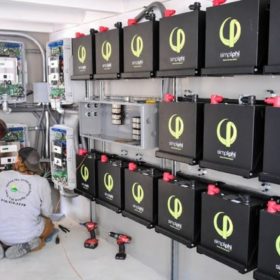
pv magazine spoke with Catherine Von Burg, CEO of the Californian battery company, to discuss why she believes lithium-iron-phosphate is the chemistry of the near future.
From pv magazine USA.
U.S.-owned analyst Wood Mackenzie last week estimated lithium-iron-phosphate (LFP) is poised to overtake lithium-manganese-cobalt-oxide (NMC) as the dominant stationary storage chemistry by 2030. While that is an ambitious prediction in its own right, one company, Simpliphi, is looking to drive the transition even sooner.
“There’s a really critical factor that’s also having an impact on the industry that may be hard to quantify at this point, or to appreciate,” Simpliphi CEO Catherine Von Burg told pv magazine. “That has to do with the ongoing hazards: fires, explosions, etc. that continue to happen because of that NMC, because of cobalt-based lithium-ion chemistries.”
Von Burg said knowledge of cobalt’s precarious position in battery chemistry is no recent discovery and steps have been made to mitigate its usage and damage potential for nearly a decade. In addition to the dangers it brings as a metal, the way the industry gets its cobalt is often less-than-savory as well.
Battery raw material sourcing
pv magazine spent the first quarter looking at raw material sourcing for batteries, as a part of our UP initiative. Topics included fair lithium in Chile, ethical strategies for cobalt supply and zero-waste batteries. Read more, stay tuned and get involved by emailing up@pv-magazine.com
“The truth is, that the earliest innovations to lithium-ion were around the cobalt-oxide,” said the boss of the California-based energy storage company. “As the industry progressed, going into 2011/12 [manufacturers began] adding in manganese, nickel and other metals to help offset or mitigate the risks that the cobalt fundamentally has. Cobalt is fundamentally toxic and hazardous. It has a very dubious supply chain, with child labor, warlord labor and all sorts of other problems.”
Swift changes
As for the chemistry revolution happening faster than expected, Simpliphi has reported 30% higher year-to-date sales for 2020, despite the global pandemic, a fact the company attributes to customers wanting safe, non-toxic back-up power for resiliency and security. There are some fairly sizable customers on the list, too, with Simpliphi announcing battery storage projects with utilities AEP and Pepco this year.
AEP and Southwestern Electric Power Co set up a demonstration of cobalt-free, intelligent energy-storage-plus-solar systems. The demo uses Simpliphi 3.8 kWh batteries, inverters and a Heila controller which acts as a battery and energy management system. The resources are controlled by the Heila Edge then aggregated to form a distributed intelligent network that can be used by any central controller.
With Pepco, Simpliphi partnered up to create a community microgrid at a new housing development, The Maycroft. The Maycroft Resiliency Center includes a 70.2 kW rooftop solar array combined with a 46 kW/56 kWh battery system that disconnects from the grid and provides power for up to three days during an unplanned power outage, according to a press release about the project.
New tech
In between predictions of an accelerated battery revolution, Von Burg also told pv magazine about her company’s newest product, the Ampliphi 3.8 kWh battery, which features a proprietary management system that calculates and transforms metrics into algorithms which protect, monitor, report, control, authenticate and balance performance.
“When we entered the market, every single one of our batteries had a BMS [battery management system] and the interface was based on voltage curves,” said the CEO. “In other words, it was smart management internal to the batteries in order to optimize performance. As the market has progressed, and as we have engaged in projects with utilities, we’ve seen the need to have even more connectivity and intelligence built into the BMS, allowing our batteries to perform above and beyond voltage curves and set points with inverter charge controller equipment to actually have digital information and interconnectivity with, for instance, microgrid site controllers.
“This Ampliphi battery’s BMS is something we’ve been working on for almost a year. What the battery enables is automatic synchronization. You don’t have to tell our battery – whether it’s one or 100 of them – that, on-site, there is an inverter charge controller, it’s already been pre-programmed to speak the inverter’s language and it syncs up.”
Lắp đặt điện mặt trời Khải Minh Tech
https://ift.tt/2X7bF6x
0906633505
info.khaiminhtech@gmail.com
80/39 Trần Quang Diệu, Phường 14, Quận 3
Lắp đặt điện mặt trời Khải Minh Tech
https://ift.tt/2ZH4TRU
Không có nhận xét nào:
Đăng nhận xét